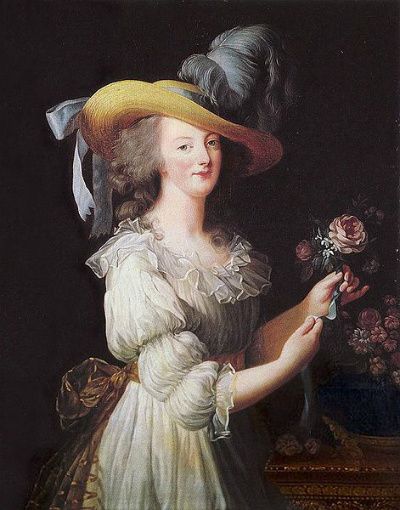It became fashionable during the late 1770's to early 1780's and at the time most courtiers thought that it resembled more a chemise in the traditional sense - that is basically underwear. The public first came head to head with the style when the portrait of Marie Antoinette was hung in a Paris salon in 1783. However, the outcry became so great that the original portrait (seen below) was removed. The English paper, the Morning Herald, mentioned in 1784 the trend as a "state of undress" which they expected to become quite popular.
 |
| Marie Antoinette's portrait that caused such a fuss |
The chemise à la Reine is made of several layers of white muslin which is loosely draped around the wearer's body. A coloured sash was bound around the bust and this was often the only colourful element in this dress. As for the shape, it was completely different from the elaborate dresses usually worn at court. Gone were the wide panniers and rustling silks with delicate embroidery.
The inspiration is believed to have come from dresses worn by washerwomen from the West Indies or from an increasing sense of Anglomania; the muslin was often imported from India. This in itself caused problems. Whereas silk had hitherto been a favourite when it came to court dress this new muslin had to be imported often at great costs. The French silk merchants were furious and quickly denounced the trend. Others had more patriotic reasons for disliking the trend. The casual style was a result of increasing English influence on fashion which had so far been all but monopolised by the French.
 |
| The Princesse de Lamballe following suit |
Surprisingly enough, the Queen's fashion statement was equally detested by courtiers and commoners alike. For once they could agree on one thing: the Queen of France was the fashion symbol of the Western world as well as an outward symbol of the glory of France. She could not be seen wearing such a simple style.
The greatest affront to the older courtiers was that no corset was worn with the dress which for centuries had been an essential part of any woman's attire.
Still, the style spread through Europe and became popular among many a noble ladies. Marie Antoinette's personal friend, the Duchess of Devonshire, wore a chemise à la Reine for an official ball while Princess Louise Augusta of Denmark had her portrait painted in one. The latter portrait was also the cause for some scandal in Denmark when an observer noted that the Princess' legs could almost be seen through the fabric - even though it was merely on canvas. Promptly, more layers of white paint were added to keep the Princess' modesty intact.
 |
| Louise Augusta of Denmark |
It is not hard to imagine that most fashionable ladies saw the style as an excuse for slipping out of the restricting court costumes and into something more comfortable.
It is rather ironic that the cut of the chemise à la Reine would later be associated with the post-Revolutionary France where a high waistline was the fashion.

No comments:
Post a Comment